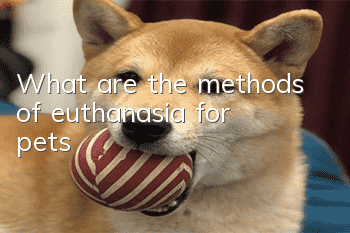What are the methods of euthanasia for pets?

How to euthanize a pet
1. Inject potassium chloride: Use 10% potassium chloride injection for rapid intravenous injection at 0.3 to 0.5 ml per kilogram of body weight, causing instantaneous hyperkalemia. High concentrations of potassium ions can cause heart block. The contractility weakens and finally inhibits the myocardium, causing sudden cardiac arrest and death. This method only shows a very short period of muscle stiffness throughout the body and then becomes flaccid and dead.
2. Oral sleeping pills: Oral sleeping pills are taken to put the sick pet to sleep, and then a central anesthetic with respiratory depression is injected. The anesthetic here usually refers to some powerful sedative drugs that can cause suffocation. Injection of powerful anesthetics suppresses the sick pet's respiratory system and eventually causes respiratory arrest and death.
3. Inject coagulant: First let the sick pet fall asleep with an anesthetic, and then inject coagulant to block the veins. The main mechanism of action of coagulants is to act on the coagulation factors of blood proteins in the animal body, causing blood coagulation, forming thrombus, causing obstruction of blood vessels, blocking blood flow, and causing the death of sick pets.
4. Injection method of sodium pentobarbital: rapid intravenous injection at 15 ml per kilogram of body weight or 75 mg per kilogram of body weight.
5. Injection of saturated magnesium sulfate method: rapid intravenous injection of 40% magnesium sulfate solution at 1 ml per kilogram of body weight.
At present, one of the most commonly used methods in domestic pet hospitals is the injection of potassium chloride, but there is also a lot of controversy about this method. The principle of death by potassium chloride is to cause instantaneous hyperkalemia by injecting potassium chloride, which will cause conduction block in the heart, weaken contractility, and ultimately inhibit the myocardium and stop the heart from beating. Although a sedative or anesthetic is injected before potassium chloride is injected, when the anesthetic dose is insufficient or ineffective, the dog will experience a painful death process, because potassium chloride will bring a strong burning sensation, and the dog may There will also be a period of generalized muscle stiffness.
In order to allow dogs to die peacefully, the sodium pentobarbital method is generally recommended abroad. Sodium pentobarbital is generally used in animal anesthesia experiments. Animals will quickly become drowsy and anesthetized after being injected with sodium pentobarbital. When used in large doses, it will inhibit the animal's breathing, and eventually the animal will die due to respiratory paralysis. Injecting sodium pentobarbital does not cause significant pain to dogs, so many organizations and owners choose this method.
The saturated magnesium sulfate method is another method that will not cause the dog to struggle and die quickly. The principle is that magnesium ions have the effect of inhibiting the central nervous system, causing loss of consciousness and directly inhibiting the respiratory and vasomotor centers of the medulla oblongata. It also blocks the conduction at the junction of peripheral nerves and skeletal muscles and relaxes the skeletal muscles.
- What to do if your puppy has diarrhea and vomiting
- How to teach a dog to potty
- Introduction to types of dog chew glue
- Reasons why dogs turn their intestines
- What to do if your dog is panting and short of breath
- Introduction to the Characteristics of Purebred Huskies
- How to clean a kennel
- Introduction to the Characteristics of Purebred Tibetan Mastiff
- How to put on a dog leash
- What are the symptoms of puppy fever?



